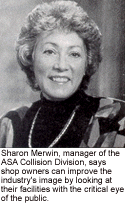What’s this? Our industry’s image is being called into question? Again? But we’re collision repair people. Why do we need to worry about image? What does image have to do with our industry? People wreck their cars, and we fix them. It’s a simple process. How does image fit in? My answer is that image fits in to everything.
The Public’s Perspective
No one I know has experienced a tremendous onslaught of potential employees lining up at the door, begging for a job. Why? Could it have something to do with our industry image?
I’d say so.
Most local vocational schools are experiencing declining numbers of applicants in the autobody repair programs. Why? Could this be attributed to the fact that the public has basically lost the reverence it once had for the "American craftsman"?
Most definitely so!
The general public has little understanding of what we do in the collision industry or how we do it, and we’ve done little to change that.
Case in point: I spoke to a shop owner recently, and he told me about a friend of his who had a mentally retarded 19-year-old son. The friend and his wife approached the shop owner and proposed that since their son was old enough to go to work but had limitations, maybe he could work at my friend’s shop. They were unaware of the very technical aspects of our industry and assumed a collision shop would provide suitable employment for their son.
Is it the parents’ fault they didn’t realize how technical our industry is? Not at all. If it’s anybody’s fault, it’s our own. We are responsible for our image. It doesn’t matter that the public’s perception of our industry is incorrect.
The fact is, for the public, perception is truth.
Recently, I attended a workshop for high school principals at a local vo-tech school. I was on the advisory board of the Autobody Repair Program and our group was discussing the benefits of choosing collision repair as a career.
One principal disclosed that when he had a student at risk of dropping out or who was involved with drugs or alcohol, he always sent him to the autobody program! Why send them to us?
Between the public and the educators, our industry is viewed as fit employment only for the mentally disabled and the drug and alcohol impaired.
This tells me that as our work has become exponentially more technical, with more complicated repair issues, the public’s perception of what we do hasn’t been enhanced at the same pace.
Many unscrupulous operators damage our image with impunity because we do nothing to stop them. These scofflaws and their hack shops denigrate the image of our industry for every hour they’re in business. Yet most legitimate repairers do nothing to bring these Neanderthals into compliance with regulations and industry standards. Why not?
Missing the Point
I attended an Automotive Service Association (ASA) annual retreat in Washington and delivered a report on legislative efforts to enact a total rebuild inspection law that would require a structural integrity inspection prior to a vehicle’s licensing. I also spoke about the control at point of sale of refinishing materials and taking them out of the hands of unregulated users (backyarders).
After the meeting, I spoke with a shop owner to solicit his support. He told me these "backyarders" and schlock operators didn’t concern him because they "… aren’t my competition. They don’t compete with me for work. We’ve got two different customer bases."
He had completely missed the point of our legislative program. It had nothing to do with competing for customers and everything to do with our industry image.
How many other shop owners hold this man’s view? How can the public, our employees, the insurance industry and ourselves, for that matter, respect our industry when horror stories are aired on national television, depicting the deadly risks consumers take when they buy a used car rebuilt from a total wreck?
Do you think the average consumer takes the time to make a distinction between a legitimate collision repairer and a hack rebuilder? Not likely. They tend to lump all shops together, and we pay the price in disparity between mechanical and collision door rates, employee shortages and lack of industry esteem. Is poor industry image the sole cause of these problems? No, but it’s a major contributing factor. Perhaps, the major contributing factor.

Industry Efforts
I spoke to Ed Dollar, president of the National Auto Body Council (NABC), a group trying to promote and improve the image of the collision repair industry both within our industry and to the public at large. When asked to describe the consuming public’s view of our industry, Dollar says: "They view us as we were in the 1940s and ’50s, unsophisticated and with big hammers. [We’re seen as] a somewhat low tech, shadowy industry. [There’s] a lack of trust by the consumer and as a secondary result, [we have] a shortage of technicians."
So what’s the NABC doing to improve industry image? "The NABC strives to increase esteem within the industry through the PRIDE Program, which nationally recognizes industry professionals for outstanding work in their communities," says Dollar. "Press releases are sent to industry papers announcing the award recipients. It’s an esteem builder. Externally, the council will soon announce the donation of a van to Ronald McDonald House and also has planned to donate five days to a Habitat for Humanity project. These humanitarian efforts are intended to help the community, while promoting the image of the collision repair industry."
Dollar advises shop owners to become involved in their communities by getting on an advisory board at a technical college; speaking at Rotary, Kiwanis and Chamber of Commerce meetings; and being active in local trade associations. Shop owners will then be more informed and better able to help increase public awareness and improve industry image.
Douglas G. Conner Jr. — an owner of Conner Brothers Body Shop in Richmond, Va., and a 1998 PRIDE Award winner — agrees that taking action is the answer.
"The public has little or no opinion of us at all," he says. "Only those who’ve used our services know anything about us. Most parents don’t want their children to enter our industry. It isn’t what they view as a future they want for their kids."
To change that negative view, Conner is doing whatever he can to improve the industry’s image. "It’s something we work at continuously. We have a half-hour infomercial program every two weeks on a local television station. Our goal is to educate the public and inform them about the collision repair business."
Conner is also very active in his community. He’s the incoming president of his local Rotary Club, and once a week he tutors inner-city high school students, which helps to let them know the public does care about them.
Like Dollar, Conner recommends that shop owners get involved in their local Rotary Club or Chamber of Commerce and also find out what they can do to help the community.
Trade Association Efforts
To get the trade association slant on the importance and effect image has on our industry, I spoke with Sharon Merwin, manager of the ASA Collision Division. What’s ASA doing to promote the image of our industry? "The Collision Division of ASA developed and promoted a written Code of Ethics," says Merwin. "We explained to our members how extremely important it was to publicize and that we believe and operate by this Code of Ethics."
ASA also presents an annual Humanitarian Award to an industry professional for outstanding service to the community, along with sponsoring NACE, one of the largest image builders in the industry. NACE brings industry professionals together and encourages improvement throughout the industry.
Merwin says shop owners can improve the industry’s image by looking at their facilities with the critical eye of the public. In other words, try to see your shop as customers see it.
She also encourages shop owners to find out what others are doing to improve their respective shops. By looking at and promoting healthy new perspectives, says Merwin, it will be easier to improve the image of your shop. And if the industry collectively does this, the overall image will be enhanced, too.
Merwin also provided me with a study commissioned by the Yellow Pages Publishers Association for ASA. This study was conducted with people whose vehicles had been collision repaired within the last six months. A total of 200 telephone interviews were completed in April of 1996. In the categories of honesty, responsiveness, cleanliness/appearance, friendliness and management, independent facilities ranked higher than new-car dealers and franchises in everything but cleanliness and appearance, with an overall score of 7.4 out of a possible 10. This was significantly higher than new-car dealerships (6.73) and franchises (5.45). The study also showed a marked increase of about 25 percent over the previous five years for independent collision repair facilities
After speaking with Merwin, I rang up Ron Weiner, president of the International Institute for Automotive Service Excellence (ASE). This organization’s primary goal is to certify those who work in the automotive industry. This technical expertise certification includes more than 30 separate automotive test categories, five of which are in the collision repair field. This is a massive effort that goes a long way to improve the consumer’s confidence in certified technicians and the shops that employ them. But ASE doesn’t stop there. They’ve also embarked on a huge advertising campaign that involves all facets of the media in an effort to improve consumer confidence in the certified technician.

Why the big advertising campaign? "They look at us as a necessary evil, a major interruption, an expensive inconvenience," says Weiner when asked how the public views us. "They don’t understand our industry."
What does ASE do to improve industry image? Weiner says ASE attempts to make a profession out of a craft by the improved legitimization of technician capabilities. "There are bookkeepers and there are CPAs," he says. "When you want the job done right, which one would you go to?"
Weiner also spoke about ASE’s motorsports campaign, which is an effort to gain wider recognition of the blue ASE logo within the public sector.
What can shop owners do to help increase public awareness of the ASE symbol? "Showcase the fact that you employ ASE certified technicians," Weiner says. "Display your ASE sign in a prominent place. If your technicians aren’t certified, encourage them to certify. It’s important to our industry, and it’s important to our image."
No Grease Monkeys Here
Industry image is a crucial factor in how the public views what we are and how they feel about our profession. From what I learned, it seems the customer’s collision repair experience has been improved by the industry. This is good. But we also need to improve our image to potential customers, not just to the customers we already have.
How can you do your part? Take a good look at your shop and get involved in your community, in industry associations and in the industry itself.
By improving ourselves, we can improve our image. It’s a simple process. And our future success may depend on it.
Writer Mike West, a contributing editor to BodyShop Business, has been a shop owner for the past 25 years and a technician for 34 years. His shop in Seattle, Wash., has attained the I-CAR Gold Class distinction and the ASE Blue Seal of Excellence.













